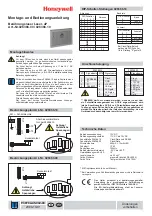
AL4142
Remote I/O module 16 DI
16
6.3 Ethernet
The device is connected to the ModbusTCP network via the Ethernet ports XF1 / XF2 (e. g.
ModbusTCP control, additional ModbusTCP device). In addition, the device can be connected to an IT
network via the Ethernet ports. The user can access functions of the ifm IoT Core via the IT network
(parameter setting software, IoT Core Visualizer).
u
Connect the device to the ModbusTCP network via a free Ethernet port.
u
Optional: Connect the device to the IT network via a free Ethernet port.
u
For connection, use an M12 connector (with at least protection rating: IP65 / IP66 / IP67).
u
Tighten the cable plug using 1.3 ± 0.1 Nm.
Wiring:
1
2
3
4
5
1: TX +
2: RX +
3: TX -
4: RX -
5: not used
6.4 Process connections
The sensors are connected to the device via the process connections.
The total current supply of the ports X1...X8 is limited to 3.6 A.
The ports feature short-circuit / overload detection.
u
Connect the sensors to ports X1...X8.
u
For connection, use M12 connectors (with at least protection rating: IP65 / IP66 / IP67; max. cable
length: 30 m).
u
Tighten the cable plug using 1.3 ± 0.1 Nm.
Wiring:
3
1
2
4
5
1: sensor supply L+ (US)
2: digital output 2 (DI2)
3: sensor supply L- (US)
4: digital output 1 (DI1)
5: functional earth (FE)
6.5 Voltage supply
The device is connected to the supply voltage US via the power IN port.
The US supply voltage supplies the device and the sensors connected to the ports X1...X8 with
voltage.
Optionally, an additional supply voltage UA can be fed to the device via the power IN port. US is
looped through to the power OUT port. UA is used exclusively to supply additional devices via the
power OUT port (daisy chain).
Port XD1 has overvoltage protection (US).
Port XD1 has reverse polarity protection (US).
The port XD1 has cross reverse polarity protection (US, UA).
















































